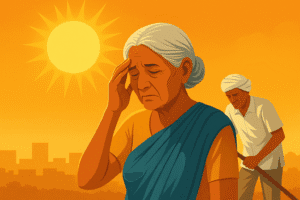Of Sun and Silver Strands: Safeguarding India’s Elderly from the Rising Heat
India’s rapidly aging population faces a severe threat from increasing heatwaves, driven by physiological vulnerabilities like reduced sweat response and thermoregulation. This risk is exacerbated by pre-existing health conditions and stark socioeconomic disparities, particularly affecting isolated rural elderly and women in poorly ventilated homes. Older outdoor laborers also face extreme danger due to prolonged exposure and social norms discouraging care. Current protection measures are insufficiently tailored to these specific vulnerabilities.
Effective response requires precise, real-time mortality data, heat action plans mandating targeted support for the elderly, and integrated early warning systems. Ultimately, safeguarding this demographic demands a shift from short-term fixes to long-term strategies that combine inclusive health resilience with decisive climate action to mitigate the root causes of rising temperatures.

Of Sun and Silver Strands: Safeguarding India’s Elderly from the Rising Heat
As Europe reeled from a devastating heatwave in the summer of 2025, a grim statistic emerged: nearly 88% of the climate-related fatalities were among those aged 65 and older. This tragic event is not a distant anomaly but a stark preview of a challenge rapidly descending upon India. With a geriatric population projected to nearly double by 2050, surpassing its youth, India stands at the convergence of a demographic shift and a climate crisis, where protecting its elderly from extreme heat is becoming a matter of national urgency.
The Anatomy of a Silent Crisis
Why are the elderly so disproportionately vulnerable to rising temperatures? The answer lies in the body’s natural aging process. Thermoregulation—the ability to maintain a stable internal temperature—diminishes with age. Older adults experience a lowered sweat response and reduced skin blood flow, making it incredibly difficult to dissipate heat efficiently. This physiological change turns even a moderate heatwave into a life-threatening event, increasing the risk of heatstroke, exhaustion, and hyperthermia.
This baseline vulnerability is compounded by pre-existing health conditions like cardiovascular or kidney disease, which are more prevalent in older populations. Furthermore, a reduced perception of thirst often leads to dangerous dehydration and electrolyte imbalances. However, the risks are not distributed equally. The crisis is deeply etched with lines of gender and socioeconomic disparity.
- The Rural Elderly Woman: Often facing the triple burden of age, gender, and poverty, she is among the most vulnerable. Confined to poorly ventilated homes with non-cooled kitchens, her caregiving roles persist even during extreme heat. Social isolation and patriarchal norms can further limit her access to cooling resources or timely aid.
- The Aging Male Labourer: In low-income settings, elderly men frequently have no option but to continue manual outdoor work in farming or construction. Prolonged exposure, combined with social norms that discourage showing weakness and sometimes alcohol use, drastically increases their risk of dehydration and heat injury.
A particularly insidious threat is the rise of ‘tropical nights,’ where temperatures remain above 20°C. This prevents the body from cooling down and recovering during sleep, placing constant strain on the cardiovascular and respiratory systems and eroding resilience night after night.
Beyond Quick Fixes: Building Systemic Resilience
While innovative solutions like personal cooling garments are being developed, their affordability and accessibility for India’s vast low-income elderly population remain a significant hurdle. The response, therefore, must be systemic, moving beyond reactive measures to forge long-term, inclusive resilience.
How policy can bridge the gap:
- Precision in Policy through Data: The first step is to untangle the conflicting mortality data. A common, nationwide nomenclature for heatwave deaths and a mandate for real-time, all-cause mortality reporting are essential. We need to know not just how many are dying, but exactly who they are—their age, gender, occupation, and pre-existing conditions. This granular data is the bedrock of effective, targeted intervention.
- Integrate and Elevate Heat Action Plans (HAPs): Most HAPs lack specific, actionable directives for the elderly. This needs to change. HAPs must:
- Mandate Risk Mapping: Identify heat islands and map vulnerable elderly populations, especially those living alone.
- Train Frontline Health Workers: Equip ASHA and anganwadi workers to conduct wellness checks, recognise early signs of heat stress, and guide the elderly on hydration and cooling.
- Create Cooled Public Spaces: Ensure community spaces like libraries, health centres, and prayer halls are designated as cooling centres during heat alerts.
- One Alert to Rule Them All: The plethora of government weather apps (UMANG, MAUSAM, Damini, etc.) creates confusion. A single, streamlined, user-friendly mobile application that integrates real-time heat alerts with practical advice for vulnerable groups would be a game-changer. This should be backed by a robust social media strategy for public outreach.
- Foster Cross-Sectoral Collaboration: Heat is not just a disaster management issue. Regular inter-ministerial meetings between Health, Environment, Urban Development, and Agriculture are crucial. Sharing insights from state-level action plans can help rapidly scale what works and abandon what doesn’t.
The Long View: Climate Action is Elderly Care
Ultimately, the most profound protection for India’s elderly is a decisive shift towards a low-carbon future. Every fraction of a degree of warming avoided translates into thousands of lives saved. Investing in renewable energy, sustainable urban planning with green spaces, and energy-efficient housing is not just an environmental imperative—it is the most comprehensive health policy for an aging nation.
The measure of a society is how it treats its most vulnerable. As the heat intensifies, India’s response will be measured by how effectively it shields its senior citizens—the farmers, the caregivers, the wisdom-keepers—from a crisis they did the least to create. Building a climate-resilient India means building a country that is safe for its grandparents to grow old
You must be logged in to post a comment.